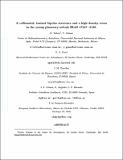Please use this identifier to cite or link to this item:
http://hdl.handle.net/10261/10756Share/Export:
 SHARE SHARE
 CORE
BASE CORE
BASE
|
|
| Visualizar otros formatos: MARC | Dublin Core | RDF | ORE | MODS | METS | DIDL | DATACITE | |

| Title: | A Collimated, Ionized Bipolar Structure and a High Density Torus in the Planetary Nebula IRAS 17347-3139 |
Authors: | Tafoya, Daniel; Gómez, Yolanda; Patel, Nimesh A.; Torrelles, José M. CSIC ORCID; Gómez Rivero, José Francisco; Anglada-Escudé, Guillem CSIC ORCID; Miranda, Luis F. CSIC ORCID; Gregorio-Monsalvo, Itziar de | Keywords: | Planetary nebulae: general Planetary nebulae: individual (IRAS 17347–3139) Radio continuum: stars Stars: AGB and post-AGB Stars: mass-loss Stars: winds, outflows |
Issue Date: | 16-Jan-2009 | Publisher: | American Astronomical Society | Citation: | Astrophysical Journal 691(1): 611-620 (2009) | Abstract: | We present observations of continuum (λ = 0.7, 1.3, 3.6, and 18 cm) and OH maser (λ = 18 cm) emission toward the young planetary nebula IRAS 17347–3139, which is one of the three planetary nebulae that are known to harbor water maser emission. From the continuum observations, we show that the ionized shell of IRAS 17347–3139 consists of two main structures: one extended (size ~ 1".5) with bipolar morphology along P.A.= –30°, elongated in the same direction as the lobes observed in the near-infrared (NIR) images, and a central compact structure (size ~ 0".25) elongated in the direction perpendicular to the bipolar axis, coinciding with the equatorial dark lane observed in the NIR images. Our image at 1.3 cm suggests the presence of dense walls in the ionized bipolar lobes. We estimate for the central compact structure a value of the electron density at least ~5 times higher than in the lobes. A high-resolution image of this structure at 0.7 cm shows two peaks separated by about 0".13 (corresponding to 100-780 AU, using a distance range of 0.8-6 kpc). This emission is interpreted as originating in an ionized equatorial torus-like structure, from whose edges the water maser emission might be arising. We have detected weak OH 1612 MHz maser emission at V(LSR) ~ –70 km s–1 associated with IRAS 17347–3139. We derive a 3σ upper limit of < 35% for the percentage of circularly polarized emission. Within our primary beam, we detected additional OH 1612 MHz maser emission in the local standard of rest velocity ranges –5 to –24 and –90 to –123 km s–1, associated with the sources J17380406–3138387 and OH 356.65–0.15, respectively. | Description: | 10 pages, 8 figures, 4 tables.-- ArXiv pre-print available at: http://arxiv.org/abs/0809.3931 | Publisher version (URL): | http://dx.doi.org/10.1088/0004-637X/691/1/611 | URI: | http://hdl.handle.net/10261/10756 | DOI: | 10.1088/0004-637X/691/1/611 | ISSN: | 0004-637X |
| Appears in Collections: | (ICE) Artículos (IAA) Artículos |
Files in This Item:
| File | Description | Size | Format | |
|---|---|---|---|---|
| 0809.3931v1.pdf | 424,65 kB | Adobe PDF |  View/Open |
CORE Recommender
SCOPUSTM
Citations
16
checked on May 5, 2024
WEB OF SCIENCETM
Citations
13
checked on Feb 24, 2024
Page view(s)
421
checked on May 6, 2024
Download(s)
256
checked on May 6, 2024
Google ScholarTM
Check
Altmetric
Altmetric
WARNING: Items in Digital.CSIC are protected by copyright, with all rights reserved, unless otherwise indicated.
